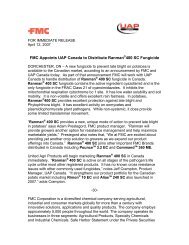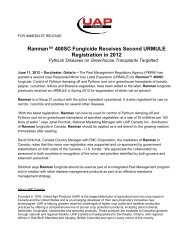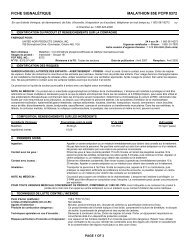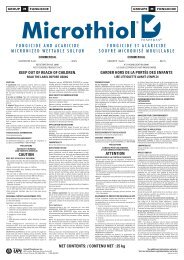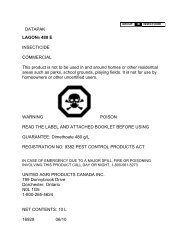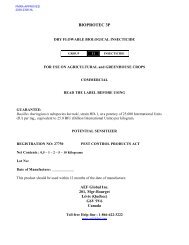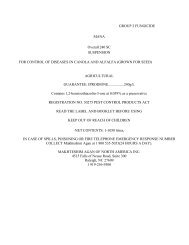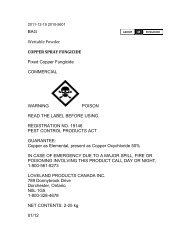Label
Label
Label
You also want an ePaper? Increase the reach of your titles
YUMPU automatically turns print PDFs into web optimized ePapers that Google loves.
DATAPAK<br />
GROUP 1B INSECTICIDE<br />
EMERGENCY USE LABEL For Sale and use only in<br />
BC and ON for the control of Spotted Wing<br />
Drosophila on sweet cherries from June 1, 2013 to<br />
November 30, 2013.<br />
MALATHION 25W<br />
WETTABLE POWDER INSECTICIDE<br />
COMMERCIAL<br />
CAUTION<br />
POISON<br />
READ THE LABEL AND BOOKLET BEFORE USING<br />
REGISTRATION NO. 14656<br />
PEST CONTROL PRODUCTS ACT<br />
GUARANTEE: Malathion 25%<br />
IN CASE OF EMERGENCY DUE TO A MAJOR SPILL, FIRE OR POISONING<br />
INVOLVING THIS PRODUCT CALL DAY OR NIGHT, 1-800-561-8273<br />
LOVELAND PRODUCTS CANADA INC.<br />
789 Donnybrook Drive<br />
Dorchester, Ontario<br />
N0L 1G5<br />
1-800-328-4678<br />
NET CONTENTS: 2 kg
GENERAL DIRECTIONS<br />
For best results apply when the temperature is 20° C or higher. Use sufficient volume of<br />
spray per hectare for good coverage of all plant parts. For sweet cherries, use a<br />
maximum of 1000 L water/ha. For proper timing of the application, the presence of adult<br />
flies should be determined through local monitoring. Repeat at 7-14 day intervals.<br />
RESISTANCE MANAGEMENT RECOMMENDATIONS<br />
For resistance management, please note that MALATHION 25W Insecticide contains a<br />
Group 1B insecticide/acaricide. Any insect/mite population may contain individuals<br />
naturally resistant to MALATHION 25W Insecticide and other Group 1B<br />
insecticide/acaricide. The resistant individuals may dominate the insect/mite population<br />
if this group of insecticides/acaricides are used repeatedly in the same fields. Other<br />
resistance mechanisms that are not linked to site of action but are specific for individual<br />
chemicals, such as enhanced metabolism, may also exist. Appropriate resistancemanagement<br />
strategies should be followed.<br />
To delay insecticide/acaricide resistance:<br />
• Where possible, rotate the use of MALATHION 25W Insecticide or other Group 1B<br />
insecticides/acaricides with different groups that control the same pests.<br />
• Avoid application of more than the indicated number of sprays of MALATHION 25W<br />
Insecticide or other insecticides/acaricides in the same group in a season.<br />
• Use tank mixtures with insecticides/acaricides from a different group when such use<br />
is permitted.<br />
• Insecticide/acaricide use should be based on an IPM program that includes<br />
scouting, record keeping and considers cultural, biological and other chemical<br />
control practices.<br />
• Monitor treated pest populations for resistance development.<br />
• Contact your local extension specialist or certified crop advisors for any additional<br />
pesticide resistance-management and/or IPM recommendations for the specific site<br />
and pest problems in your area.<br />
• For further information and to report suspected resistance, contact the Technical<br />
Service, Loveland Products Canada Inc., 1-800-328-4678 or at www.uap.ca.<br />
Product Specific Precautions<br />
Read and understand the entire label before opening this product. If you have<br />
questions, call the manufacturer at 1-800-328-4678 or obtain technical advice from the<br />
distributor or your provincial agricultural representative. Application of this specific<br />
product must meet and/or conform to the following:<br />
ENVIRONMENTAL HAZARDS:<br />
TOXIC to aquatic organisms. Observe buffer zones specified under DIRECTIONS FOR<br />
USE.<br />
TOXIC to birds.
TOXIC to bees exposed to direct treatment, drift, or residues on flowering crops or weeds.<br />
DO NOT apply this product to flowering crops or weeds if bees are visiting the treatment area.<br />
Minimize spray drift to reduce harmful effects on bees in habitats close to the application site.<br />
TOXIC to certain beneficial insects. Minimize spray drift to reduce harmful effects on beneficial<br />
insects in habitats next to the application site such as hedgerows and woodland.<br />
To reduce runoff from treated areas into aquatic habitats avoid application to areas with a<br />
moderate to steep slope, compacted soil, or clay.<br />
Avoid application of this product when heavy rain is forecast.<br />
Contamination of aquatic areas as a result of runoff may be reduced by including a vegetative strip<br />
between the treated area and the edge of the water body.<br />
The use of this chemical may result in contamination of groundwater particularly in areas where<br />
soils are permeable (for example, sandy soil) and/or the depth to the water table is shallow.<br />
DIRECTIONS FOR USE<br />
As this product is not registered for the control of pests in aquatic systems, DO NOT use to control<br />
aquatic pests.<br />
DO NOT contaminate irrigation or drinking water supplies or aquatic habitats by cleaning of<br />
equipment or disposal of wastes.<br />
Field sprayer application: DO NOT apply during periods of dead calm. Avoid application of this<br />
product when winds are gusty. DO NOT apply with spray droplets smaller than the American<br />
Society of Agricultural Engineers (ASAE) medium. Boom height must be 60 cm or less above the<br />
crop or ground.<br />
Airblast application: DO NOT apply during periods of dead calm. Avoid application of this product<br />
when winds are gusty. DO NOT direct spray above plants to be treated. Turn off outward pointing<br />
nozzles at row ends and outer rows. DO NOT apply when wind speed is greater than 16 km/h at<br />
the application site as measured outside of the treatment area on the upwind side.<br />
BUFFER ZONES<br />
Use of the following spray methods or equipment DO NOT require a buffer zone: hand-held or<br />
backpack sprayer and spot treatment.<br />
The buffer zones specified in the table below are required between the point of direct application<br />
and the closest downwind edge of sensitive freshwater habitats (such as lakes, rivers, sloughs,<br />
ponds, prairie potholes, creeks, marshes, streams, reservoirs and wetlands) and estuarine/marine<br />
habitats.
Method of<br />
application<br />
Airblast (Late<br />
growth stage)<br />
Crop<br />
Cherry<br />
Freshwater Habitat of<br />
Depths:<br />
Less than Greater than<br />
1 m 1 m<br />
Estuarine/Marine<br />
Habitats of Depths:<br />
Less Greater than<br />
than 1 m 1 m<br />
15 5 25 20<br />
For tank mixes, consult the labels of the tank-mix partners and observe the largest (most<br />
restrictive) buffer zone of the products involved in the tank mixture and apply using the coarsest<br />
spray (ASAE) category indicated on the labels for those tank mix partners.<br />
DIRECTIONS FOR USE<br />
NOTE TO USER: READ THE FOLLOWING BEFORE USING THIS PRODUCT FOR<br />
THE INDICATED SPECIAL USE APPLICATIONS:<br />
The DIRECTIONS FOR USE for this product for the use described below were<br />
developed by persons other than Loveland Products Canada Inc. Loveland Products<br />
Canada Inc. itself makes no representation or warranty with respect to performance<br />
(efficacy) or crop tolerance (phytotoxicity) claims for this product when used on the crop<br />
listed below.<br />
Accordingly, the Buyer and User assume all risks related to performance and crop<br />
tolerance arising, and agree to hold Loveland Products Canada Inc. harmless from any<br />
claims based on efficacy or phytotoxicity in connection with the use described below.<br />
DIRECTIONS FOR USE<br />
SWEET CHERRIES<br />
For foliar application only, using conventional ground application equipment. Ensure<br />
sufficient water volume is used to guarantee thorough coverage. Use a maximum of<br />
1000 L of water per hectare. Timing of applications should be based on the presence of<br />
adult pest (flies), as determined by local monitoring. Consult extension specialists for<br />
timing. Treat when bees are absent from field.<br />
Crop Pest Rate product<br />
per 1000 L<br />
of water<br />
sweet<br />
cherry<br />
Spotted<br />
Wing<br />
Drosophila<br />
(Drosophila<br />
suzukii)<br />
Maximum<br />
No. of<br />
Applications<br />
Application<br />
Interval<br />
Days<br />
Before<br />
Harvest<br />
Restricted entry<br />
interval<br />
2.5-3.75 kg 1 7-14 days 3 Handthinning:<br />
3 days.<br />
All other<br />
activities: 1 day.
PRECAUTIONS<br />
KEEP OUT OF REACH OF CHILDREN.<br />
Harmful if swallowed. Avoid breathing spray mist. Avoid repeated or prolonged<br />
contact with skin, eyes and clothing. Wash thoroughly. Avoid contamination of feed<br />
and foods. Wear long pants, long sleeved shirts and chemical-resistant gloves<br />
during mixing/loading, application, clean-up and repair. Chemical-resistant gloves<br />
are not required while operating groundboom sprayers.<br />
DO NOT use in buildings. Do not contaminate drinking troughs. Wash after handling<br />
or using. Avoid contamination of ponds, lakes, streams and other bodies of water<br />
which contain fish life or which may be used for irrigation or domestic purposes. Use<br />
a respirator when spraying in closed areas. Apply only when the potential for drift to<br />
areas of human habitation or areas of human activity such as houses, cottages,<br />
schools and recreational areas is minimal. Take into consideration wind speed,<br />
wind direction, temperature inversions, application equipment and sprayer settings.<br />
This product contains a petroleum distillate which is moderately to highly toxic to<br />
aquatic organisms. Avoid contamination of aquatic systems during application. Do not<br />
contaminate these systems through direct application, disposal of waste or cleaning<br />
equipment.<br />
If this pest control product is to be used on a commodity that may be exported to the<br />
U.S. and you require information on acceptable residue levels in the U.S., visit<br />
CropLife Canada’s website at www.croplife.ca/.<br />
FIRST AID<br />
IF ON SKIN OR CLOTHING: Take off contaminated clothing. Rinse skin immediately<br />
with plenty of water for 15-20 minutes. Call a poison control centre or doctor for<br />
treatment advice.<br />
IF IN EYES: Hold eye open and rinse slowly and gently with water for 15-20 minutes.<br />
Remove contact lenses, if present, after the first 5 minutes, then continue rinsing eye.<br />
Call a poison control centre or doctor for treatment advice.<br />
IF SWALLOWED: Call a poison control centre or doctor immediately for treatment<br />
advice. Do not induce vomiting unless told to do so by poison control centre or doctor.<br />
Do not give any liquid to the person. Do not give anything by mouth to an unconscious<br />
person.<br />
IF INHALED: Move person to fresh air. If person is not breathing, call 911 or an<br />
ambulance, then give artificial respiration, preferable by mouth-to-mouth, if possible.<br />
Call a poison control centre or doctor for treatment advice.<br />
Take container, label or product name and Pest Control Product Registration Number<br />
with you when seeking medical attention.
TOXICOLOGICAL INFORMATION<br />
Malathion is an organophosphate that is a cholinesterase inhibitor. Typical symptoms<br />
of overexposure to cholinesterase inhibitors include headache, nausea, dizziness,<br />
sweating, salivation, runny nose and eyes. This may progress to muscle twitching,<br />
weakness, tremor, incoordination, vomiting, abdominal cramps and diarrhea in more<br />
serious poisonings. A life-threatening poisoning is signified by loss of consciousness,<br />
incontinence, convulsions and respiratory depression with a secondary cardiovascular<br />
component. Treat symptomatically. If exposed, plasma and red blood cell<br />
cholinesterase tests may indicate degree of exposure (baseline data are useful).<br />
Atropine, only by injection, is the preferable antidote. Oximes, such as pralidoximone<br />
chloride, may be therapeutic if used early; however, use only in conjunction with<br />
atropine. Incases or severe acute poisoning, use antidotes immediately after<br />
establishing an open airway and respiration. With oral exposure, the decision of<br />
whether to induce vomiting or not should be made by an attending physician.<br />
Contains petroleum distillate – vomiting may cause aspiration pneumonia.<br />
STORAGE: Store away from food and feed.<br />
DISPOSAL<br />
1. Thoroughly empty the contents of the container into the application device.<br />
2. Make the empty container unsuitable for further use.<br />
3. Dispose of the container in accordance with provincial requirements.<br />
4. For information on the disposal of unused, unwanted product, contact the<br />
manufacturer or the provincial regulatory agency. Contact the manufacturer and the<br />
provincial regulatory agency in case of a spill, and for clean-up of spills.<br />
NOTICE TO USER: This pest control product is to be used only in accordance with the<br />
directions on this label. It is an offence under the PEST CONTROL PRODUCTS ACT<br />
to use this product in a way that is inconsistent with the directions on the label. The user<br />
assumes the risk to persons or property that arises from any such use of this product.



